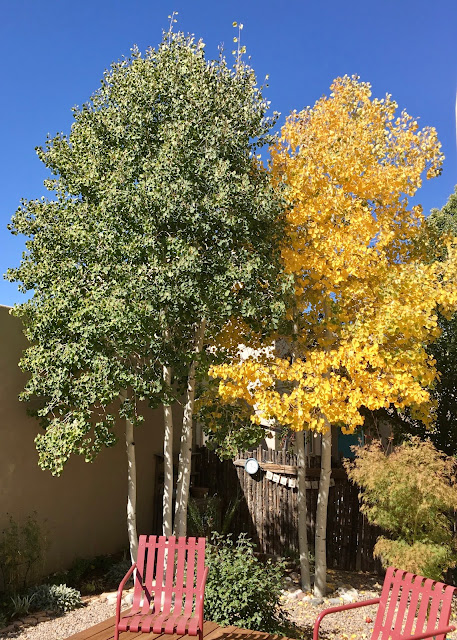Another One Bites the Dust
Aspens are widely planted and beloved in the west for their narrow forms and beautiful white bark. Bright yellow fall color is a plus. And there is nothing like the twinkling of leaves on quaking stems in a summer breeze.
But they don't do well in urban landscapes. They are mountain trees not city trees. I can see the stumps of two in our yard that were taken down before we moved in. Five remained, but one of those has now bitten the dust.
There were two aspens there, side by side, and the leftmost was still green and leafy. My tree guy says he could maybe save the browned, dead looking one, it wasn't completely gone and still had some life in it.
But both had grown skinny and contorted by being so close to the house. They add nothing visually and little shade at this point. There are other nicer ones to enjoy -- the two in our back yard are beautiful -- crowded, but with just enough room to grow.
And we see the neighbor's trees, which are close to buildings, but seem to have enough room to spread out.
The struggling, misshapen one in front of our window has now been taken down. Three men showed up from my tree company. One was a young, slender teen, one was a youngish middle aged man and the third was a grizzled old gray bearded portly guy. It was the old guy who hoisted himself up on ropes to the top of the tree and sawed away, grunting in Spanish.
The tree was dispatched with care.
There are two schools of advice about planting aspens in our area. The Santa Fe Botanical Garden says don't. They aren't suited to conditions in home landscapes.
The other view is to plant and re-plant. They die, so when one bites the dust, take it down and put another in. In fact, plant lots, as several will go and you'll still have some. Re-plant all the time; they are fast growers and you will always have twinkling aspens in your landscape if you have lots and replace what dies.
I won't replant this aspen that has been removed.




Comments